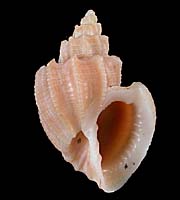|
< Previous family introduction |
|
|||||
 |
Family Cancellariidae Nutmegs or Basket Shells
|
|||||
|
Members of the family Cancellariidae have medium to small shells, often with both axial and spiral sculpture producing a basket-like (or cancellate) effect from which the family is named. The family contains several hundred species, these having polar, temperate or tropical distributions. It is divided into three or four subfamilies, the shells of which vary considerably in form. The recently created subfamily Plesiotritoninae contains high spired shells with varices; its members had previously been placed in either the Buccinidae, Ranellidae or Fasciolariidae. The characteristic feature of the Cancellariidae is a modified anterior alimentary system, with a long proboscis and a radula that has a single row of very long, narrow, ribbon-like teeth. The cancellariids appear to be suctorial feeders, with the alimentary system adjusted to that purpose. One Californian species, Cancellaria cooperi, feeds on an electric ray. It crawls onto the sleeping ray at night, locating it from distances of up to 24 metres away, makes cuts in the undersurface, and then sucks out the blood. There are also reports of cancellariids feeding on sand-dwelling bivalves and gastropods, as well as fish pieces and squid eggs (Loch, 1987). Only one of the NSW species is at all common. This is Cancellaria undulata, which lives in the shallow subtidal in bays and estuaries, and washes up on beaches. A few other species occur uncommonly on beaches, but the rest occur on the continental slope and shelf. The small species from the continental shelf are uncommon to rare, some only being known from one or two specimens. The NSW species were reviewed by Laseron (1955), who listed 11 species. The Australian species were reviewed by Garrard (1975), who increased the number of NSW species to 19 by adding the continental shelf fauna. The present treatment records additional species in the NSW fauna and creates several synonyms, recognising 18 species. Family References Beu, A.G. and Maxwell, P.A. 1987. A revision of the fossil and living gastropods related to Plesiotriton Fisher, 1884 (Family Cancellariidae, Subfamily Plesiotritoninae n. subfam.). New Zealand Geological Survey Paleontological Bulletin 54 Garrard, T.A. 1975. A revision of the Australian Cancellariidae (Gastropoda: Mollusca). Records of the Australian Museum 30(1):1-62 Laseron, C.F. 1955. The New South Wales Cancellariidae. Records of the Australian Museum 23(5):267-272 Petit, R.E. and Harasewych, M.G. 1990. Catalogue of the superfamily Cancellarioidea Forbes and Hanley, 1851 (Gastropoda: Prosobranchia). Nautilus Supp. 1:1-69 Verhecken, A. 1986. The recent Cancellariidae of Indonesia (Neogastropoda: Cancellariacea). Gloria Maris 25(2):29-66 The following species was reported from NSW by Laseron (1975), but the status is doubtful:
These are tropical Indo-West Pacific species, which have been rarely recorded from NSW:
Identification Notes Shell features differ between the four subfamilies: Cancellariinae: heavy shell, cancellate sculpture, three columella plaits, umbilicus closed. Admetinae: Small, thin shell, umbilicus closed, no columella plaits Trigonostominae: High, strongly shouldered shell, umbilicus open, two or three columella plaits Pleisotritoninae: Very high spired shell with varices
|